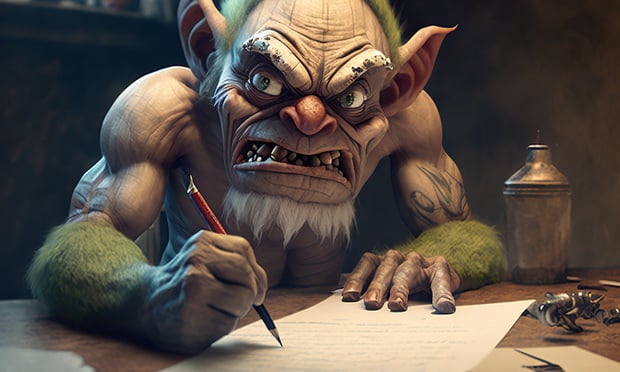Features

Internet Archive’s Decision Not to Appeal Second Circuit’s Fair Use Ruling Could Lead to More Litigation As Issue Remains Unsettled
The Second Circuit’s decision may have significant downstream implications for other digital lending services, making it more difficult to operate absent licensing agreements with copyright holders of the various works they seek to distribute. With Internet Archive deciding against petitioning the Supreme Court, we may well see similar litigation pop up in other jurisdictions outside the Second Circuit until the issue is more widely settled.
Features

Sending a Shot Across the Brow: Drafting An Effective Trademark Demand Letter
At the end of the day, demand letters form an important part of a company's trademark enforcement strategy. But they must be just that — a part of a fully developed reasoned strategy rather than a knee-jerk reaction to perceived infringement. And that strategy will require some investigation and research to help ensure success.
Columns & Departments

IP News
Federal Circuit: PTAB Jurisdiction Exists Over Expired PatentsFederal Circuit: No Estoppel on Unadjudicated Claims
Features

Supreme Court Hears Arguments In Corporate Trademark Infringement Remedy Calculation Case
The business-law issue of whether and when a corporate defendant is considered distinct from its affiliated entities emerged on December 11 at the U.S. Supreme Court, with the justices confronting whether a non-defendant’s affiliate’s revenue can be part of a judge’s calculation of the monetary remedy for the corporate defendant’s infringement of a trademark.
Features

Exploring Generative AI’s Impact on Intellectual Property
This article highlights some of the challenges GenAI presents, and recent developments in copyright law and trademark law in this quickly evolving space.
Features

Navigating AI Risks: Best Practices for Compliance
Businesses are working to navigate AI responsibly, driven by legal compliance and concerns over potential misuse. Mismanaged AI could jeopardize critical systems and erode customer trust, underscoring the need for thoughtful implementation and oversight.
Columns & Departments
IP News
Federal Circuit: District Courts May Impose Deterrence Sanctions Even After They Had Already Awarded Attorney Fees and Costs Under 35 U.S.C. §285Federal Circuit: To Properly Claim A Negative Limitation, There Must Be SupportFederal Circuit: The Mere Beginning of a Step In a Claimed System Does Not Satisfy the Limitation
Features

Secondary Liability for Copyright Infringement At the Supreme Court
In February 2024, the Fourth Circuit addressed a jury’s 2020 damages award of $1 billion finding Cox secondarily liable for its subscribers’ copyright infringement through illegal copying of copyrighted songs. Both Cox and Sony filed petitions for certiorari.
Features

Combatting Patent Trolls
A subject of extensive debate within the U.S. patent system has been the classification of “patent trolls” — most widely defined as individuals or companies that acquire patents solely for the purpose of assertion, often in cases without any merit, but which leverage the high cost of patent litigation defense to force small settlements.
Features

What Can IP Practitioners Expect from Trump 2.0?
President-elect Donald Trump did not make intellectual property (IP) policy a major focus of his 2024 election campaign, but his policy priorities are nearly certain to have a profound effect on the IP landscape when he takes office in January.
Need Help?
- Prefer an IP authenticated environment? Request a transition or call 800-756-8993.
- Need other assistance? email Customer Service or call 1-877-256-2472.
MOST POPULAR STORIES
- Second Circuit Reinforces Bankruptcy Code Settlement Payment Safe HarborThe Second Circuit affirmed the lower courts' judgment that a "transfer made … in connection with a securities contract … by a qualifying financial institution" was entitled "to the protection of ... §546 (e)'s safe harbor ...."Read More ›
- The DOJ's Corporate Enforcement Policy: One Year LaterThe DOJ's Criminal Division issued three declinations since the issuance of the revised CEP a year ago. Review of these cases gives insight into DOJ's implementation of the new policy in practice.Read More ›
- The DOJ's New Parameters for Evaluating Corporate Compliance ProgramsThe parameters set forth in the DOJ's memorandum have implications not only for the government's evaluation of compliance programs in the context of criminal charging decisions, but also for how defense counsel structure their conference-room advocacy seeking declinations or lesser sanctions in both criminal and civil investigations.Read More ›
- Use of Deferred Prosecution Agreements In White Collar InvestigationsThis article discusses the practical and policy reasons for the use of DPAs and NPAs in white-collar criminal investigations, and considers the NDAA's new reporting provision and its relationship with other efforts to enhance transparency in DOJ decision-making.Read More ›
- Questions Every Law Firm Business Development Leader Should Be AskingIn a legal marketplace transformed by technology, heightened client expectations, and fierce competition, law firm leaders must approach strategy with rigor and clarity. The following questions, accompanied by relevant statistics and explanations, offer a focused guide for uncovering opportunity and driving sustainable growth.Read More ›
